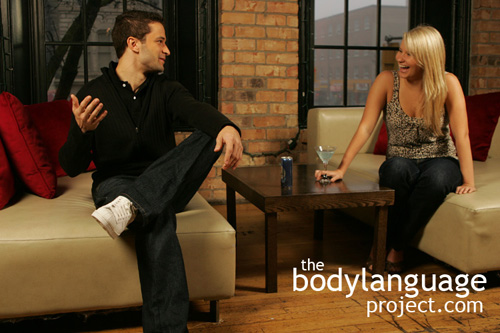In this third chapter we examined and compared the various influences on body language: genetic, learned and cultural. We found that in terms of genetics we all show similar roots and so display similarly across cultures, but that learning does play a role in how we might signal. We also covered emblems, illustrators, affect displays, adaptors and regulators which all form a part of what is called kinesics or how nonverbal behaviour relates to movement. Emblems, we found, are quotable gestures that are culturally specific which can be used as replacement for words and have a direct verbal translation. Illustrators are a second type of gesture that we use while speaking to help us paint a more descriptive picture such as talking about a boxing match and using a punching motion. Affect displays is nonverbal language that reveal our emotional state such as smiling or frowning and adaptors are movements or gestures that are used to manage our feelings or control our responses such as postural changes. Sometimes these adaptors have hidden meaning, but other times they do not, so caution is warranted. Regulators on the other hand control turn taking and flow when people speak with one another. Finally we covered high and low context cultures as it relates to touching and the ways various cultures meet and greet one another.
Tag Archive for Kinesics
Regulators, Regulate Speech
by Chris Site Author • March 5, 2013 • 0 Comments
The final type of gestures are called regulators because they are used to modulate and maintain the flow of the speech during conversation. Essentially, we use regulators to control turn-taking in conversation and they can take the form of kinesic such as head nods or nonkinesic such as eye movements. Regulators are different across cultures more so than any other element of body language discussed thus far.
In a study by Marjorie Vargas in 1986, it was noted that black students in the United States felt insulted by the white educators. The educators weren’t picking up on cues that the students understood what was being instructed. For example, the white students would nod and murmur “uh-huh” but the black students would nod much less and use “mhm” instead. The teachers took this to mean that the students didn’t fully understand the material, but this wasn’t so, they just expressed their understanding differently.
In Japan, the up and down nod of the head or “yes motion” is utilized not to show ‘agreement’ but to show ‘understanding’. Therefore, while pitching a new idea or venture, it would be foolish to think that the continuous head nodding by the Japanese was do to their willingness to invest. Creating a simple dos and don’ts list is not feasible for these nonverbal kinesics in speech for the simple fact that there are far too many to list and the variation of meaning across culture is so varied. With the simple awareness of emblems, illustrators, affect displays, adaptors and regulators the incidence of misinterpreting their meaning can be reduced.
Caution is therefore important when dealing with international business so as to avoid any harm in interpretation. Some other examples of regulators include putting the hand up to signal that you are ready to speak, putting the finger up to the mouth to bring silence, waiving the hand around in a circle so as to speed things up, rolling of the eyes showing disapproval, a gasp to show shock, throwing the hand to someone to include them in the conversation, or shaking the head disapprovingly. All these gestures control the flow and pattern of speech by directing, disapproving, speeding things up or slowing them down, and even cutting the speaker short.
Using regulators in speech is necessary to create seamless turn-taking and to avoid appearing rude, dominating or frustrating the people you are talking with. It prevents having to interrupt, eases the flow of speech and allows everyone to make the points they wish to make without having to cut each other off mid-sentence. The net effect of a good conversation is connectivity through the creation of seamless turn-taking.
Emblems, Illustrators, Affect Displays, Adaptors And Regulators
by Chris Site Author • March 5, 2013 • 0 Comments
Gestures are used in speech to convey information more efficiently or to express attitudes or emotions and as a body language reader they give us clues as to the speakers mental framework from which they speak. Beneficial byproducts of gestures include making speech occur more smoothly and increased liking between speakers and listeners. In the following section we will cover “kinesics” which is the subclass of nonverbal body language that is related to movement. Kinesics is probably the most talked about and most common type of body language but also the most easily confused cross-culturally.
The first full length study on gesture was published in 1644 by John Bulwer. He catalogued dozens of gestures and produced a guide on how to increase clarity and eloquence in public speaking. Further research has shown that some gestures are universal and therefore have ubiquitous meaning across cultures, while others only have local meaning. Other gestures are context specific so mean one thing in one place and can mean something entirely different elsewhere. Pointing, made by extending the index finger and balling up the rest of the hand for example, is one of the gestures that has the same meaning everywhere, but the okay-sign made by touching the index finger to the thumb and flaring out the remaining fingers, as we shall see later, does not.
Some cultures also tend to gesture, called “gesticulation” when used in speech, more or less often than others. For example, Italians are known to use a lot of gestures in speech whereas the English tend to use gestures infrequently. The English culture, on the other hand, deems high rates of gesticulation as being impolite. The high gesture cultures include Hebrew, French and Spanish.
The more social way for us to use our hands is to use them in concert with what is being said, although taken to extremes like the Italians, or lack thereof like the English, can be counterproductive. A balance between the two, will be the best case. The hands and arms add to the dialogue and liven it. Keeping your hands to your sides or your arms crossed tightly might be comfortable, but those that use their hands moderately while speaking appear intelligent and honest when viewed by others. Universally, closed posture come off as negative and anti-social no matter what kinds of truths spoken or positive feelings intended by the speaker. This is why it’s so important to be conscious of our gestures because even if we aren’t, others will be. Whether or not others bring closed body language to consciousness, is not relevant. Our impressions are created in others passively with no active thinking.
The various gestures have been broken down into five categories: emblems, illustrators, affect displays, regulators which we cover next.


